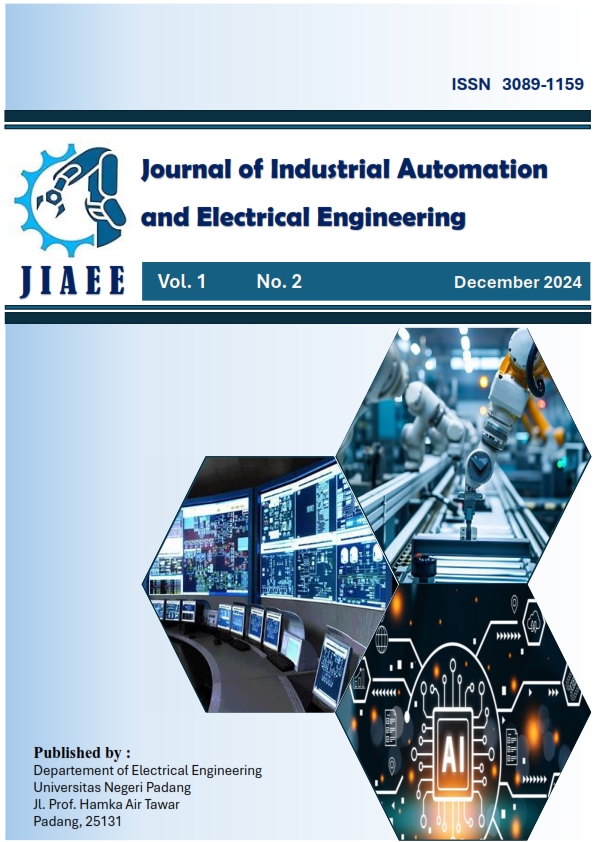Improving MPPT system performance through improved Perturb and Observe algorithm in solar power plant system
DOI:
https://doi.org/10.24036/x1r9vm59Keywords:
Photovoltaic, MPPT, Improved P&O , Irradiance , EfficiencyAbstract
This study evaluates the performance of Maximum Power Point Tracking (MPPT) algorithms using conventional and modified Perturb and Observe (P&O) methods in photovoltaic systems. Tests were conducted across irradiance levels of 200-600 W/m². Results demonstrate that the modified P&O method significantly reduces oscillations and improves convergence speed compared to the conventional approach. At 600 W/m² irradiance, the modified method achieves MPP in 325 ms with 9.85 W power output, while the conventional method requires 345 ms, producing 8.775 W. Increased irradiance correlates positively with power output and negatively with MPP tracking time. This research validates the effectiveness of the modified P&O method in enhancing efficiency and stability of MPPT systems in photovoltaic applications
Downloads
References
[1] K. S. Tey and S. Mekhilef, "Modified Incremental Conductance Algorithm for Photovoltaic System Under Partial Shading Conditions and Load Variation," IEEE Transactions on Industrial Electronics, vol. 61, no. 10, pp. 5384-5392, Oct. 2014, doi: 10.1109/TIE.2014.2304921.
[2] Asnil, Krismadinata, E. Astrid., and I. Husnaini, “Enhanced Incremental Conductance Maximum Power Point Tracking Algorithm for Photovoltaic System in Variable Conditions,” vol. 57, no. 1, pp. 33–43, 2024.
[3] Asnil, Krismadinata, I. Husnaini, and E. Astrid, “Characteristics Of Photovoltaic Modules In Various Configurations For Partial Shading Conditions,” Journal of Theoretical and Applied Information Technology, vol. 99, no. 22, 2021
[4] M. Alsumiri, "Residual Incremental Conductance Based Nonparametric MPPT Control for Solar Photovoltaic Energy Conversion System," IEEE Access, vol. 7, pp. 87901-87906, 2019, doi: 10.1109/ACCESS.2019.2925687.
[5] M. Dhimish, "70% Decrease of Hot-Spotted Photovoltaic Modules Output Power Loss Using Novel MPPT Algorithm," IEEE Transactions on Circuits and Systems II: Express Briefs, vol. 66, no. 12, pp. 2027-2031, Dec. 2019, doi: 10.1109/TCSII.2019.2893533.
[6] H. Li, D. Yang, W. Su, J. Lü, and X. Yu, “An overall distribution particle swarm optimization MPPT algorithm for photovoltaic system under partial shading,” IEEE Trans. Ind. Electron., vol. 66, no. 1, pp. 265–275, Jan. 2019, doi: 10.1109/TIE.2018.2829668.
[7] M. Lasheen, A. K. A. Rahman, M. Abdel-Salam, and S. Ookawara, “Adaptive reference voltage-based MPPT technique for PV applications,” IET Renew. Power Gener., vol. 11, no. 5, pp. 715–722, Apr. 2017, doi: 10.1049/iet-rpg.2016.0749.
[8] I. F. Sanul and M. Yuhendri, “Sistem Kendali MPPT Panel Surya Dengan Menggunakan Algoritma Jaringan Saraf Tiruan,” JTEIN J. Tek. Elektro Indones., vol. 4, no. 1, pp. 345–352, 2023.
[9] S. Tang, “An enhanced MPPT method combining fractional-order and fuzzy logic control,” IEEE J. Photovolt., vol. 7, no. 2, pp. 640–650, Mar. 2017, doi: 10.1109/JPHOTOV.2017.2649600.
[10] L. Shang, H. Guo and W. Zhu, "An Improved MPPT Control Strategy Based on Incremental Conductance Algorithm," Protection and Control of Modern Power Systems, vol. 5, no. 2, pp. 1-8, April 2020, doi: 10.1186/s41601-020-00161-z.
[11] W. Jinpeng, Y. Qinxue, Z. Bo, Jeremy-Gillbanks and Z. Xin, "Study on MPPT Algorithm Based on an Efficient Hybrid Conjugate Gradient Method in a Photovoltaic System," IEEE Access, vol. 11, pp. 4219-4227, 2023, doi: 10.1109/ACCESS.2022.3233826.
[12] M. Yuhendri and G. S. Putra, “Implementasi Sistem Kendali MPPT Panel Surya Berbasis Algoritma Incremental Conductance,” JTEIN J. Tek. Elektro Indones., vol. 1, no. 2, pp. 218–223, 2020, doi: 10.24036/jtein.v1i2.72.
[13] S. Xu, R. Shao, B. Cao and L. Chang, "Single-phase grid-connected PV system with golden section search-based MPPT algorithm," Chinese Journal of Electrical Engineering, vol. 7, no. 4, pp. 25-36, Dec. 2021, doi: 10.23919/CJEE.2021.000035.
[14] O. Abdel-Rahim and H. Wang, "A new high gain DC-DC converter with model-predictive-control based MPPT technique for photovoltaic systems," CPSS Transactions on Power Electronics and Applications, vol. 5, no. 2, pp. 191-200, June 2020, doi: 10.24295/CPSSTPEA.2020.00016.
[15] D. C. Huynh, T. N. Nguyen, M. W. Dunnigan, and M. A. Muller, “Dynamic particle swarm optimization algorithm based maximum power point tracking of solar photovoltaic panels,” in Proc. IEEE Int. Symp. Ind. Electron. Conf., May 2013, pp. 1–6.
[16] H. Masrepol and M. Yuhendri, “Implementasi MPPT Panel Surya Berbasis Algoritma Perturbasi & Observasi (PO) Menggunakan Arduino,” JTEIN J. Tek. Elektro Indones., vol. 2, no. 2, pp. 162–167, 2021, doi: 10.24036/jtein.v2i2.155.
[17] S. Lyden and M. E. Haque, “Comparison of the perturb and observe and simulated annealing approaches for maximum power point tracking in a photovoltaic system under partial shading conditions,” in Proc. IEEE Energy Convers Congr. Expo., Sep. 2014, pp. 2517–2523.
[18] K. Ishaque, Z. Salam, M. Amjad, and S. Mekhilef, “An improved particle swarm optimization (PSO) based MPPT for PV with reduced steady-state oscillation,” IEEE Trans. Power Electron., vol. 27, no. 8, pp. 3627–3638, Aug. 2012.
[19] A. Lindo and M. Yuhendri, “Sistem Kendali Daya Maksimum Panel Surya Berbasis Fuzzy Logic Controller,” JTEIN J. Tek. Elektro Indones., vol. 3, no. 1, pp. 102–110, 2022, doi: 10.24036/jtein.v3i1.207.
[20] H. Renaudineau et al., “A PSO-based global MPPT technique for distributed PV power generation,” IEEE Trans. Ind. Electron., vol. 62, no. 2, pp. 1047–1058, Feb. 2015.
[21] Q. Zhu, X. Zhang, S. S. Li, C. Liu, and H. Ni, “Research and test of power loop based dynamic multi-peak MPPT algorithm,” IEEE Trans. Ind. Electron., vol. 63, no. 12, pp. 7349–7359, Dec. 2016.
[22] Y. Zhou, C. N. M. Ho and K. K. -M. Siu, "A Fast PV MPPT Scheme Using Boundary Control With Second-Order Switching Surface," IEEE Journal of Photovoltaics, vol. 9, no. 3, pp. 849-857, May 2019, doi: 10.1109/JPHOTOV.2019.2899470.
[23] H. D. Tafti, C. D. Townsend, G. Konstantinou and J. Pou, "A Multi-Mode Flexible Power Point Tracking Algorithm for Photovoltaic Power Plants," IEEE Transactions on Power Electronics, vol. 34, no. 6, pp. 5038-5042, June 2019, doi: 10.1109/TPEL.2018.2883320.
[24] T. Esram and P. L. Chapman, “Comparison of photovoltaic array maximum power point tracking techniques,” IEEE Trans. Energy Convers., vol. 22, no. 2, pp. 439–449, Jun. 2007.
[25] S. Sajadian and R. Ahmadi, “Model predictive-based maximum power point tracking for grid-tied photovoltaic applications using a Z-source inverter,” IEEE Trans. Power Electron., vol. 31, no. 11, pp. 7611–7620, Nov. 2016







